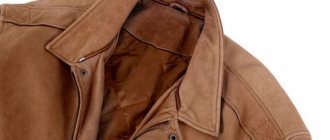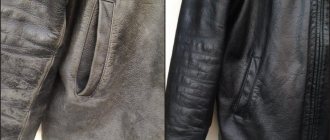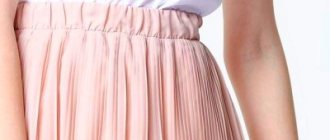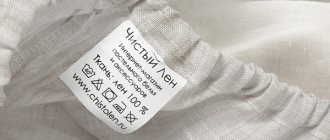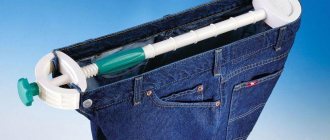How to prepare the product for cleaning
To understand how and with what to clean a suede jacket, determine the degree of contamination and prepare the product. Remove all items from your pockets, shake the jacket and hang it on a hanger. Inspect the sleeves, collar, lining. Mark the most severe stains that require local treatment.
Before you begin removing stains, rid the surface of dust and dried raindrops. To do this, use a vacuum cleaner or a crepe brush, which is specially made for nubuck and suede.
It is recommended to use a crepe brush to clean suede.
Regardless of the tool you choose, act carefully: do not scrub too hard, use a vacuum cleaner at low power. Otherwise, you will damage the pile and deform the jacket.
To remove stains and comb lint, prepare a double-sided brush with bristles and rubber pads. You will also need soft rags, sponges, and a spray bottle.
Cleaning the lining
The lining of outerwear is constantly in contact with other clothing , which is why it quickly becomes dirty. If you need to wash the lining, you need to dilute the washing powder in warm water and treat it with a sponge. Then you need to rinse off the product with a stream of shower. It is important to prevent washing powder from getting on the front surface of the product to avoid streaks.
After rinsing, the lining should be blotted with a dry cloth. When you need to wash both the surface of the jacket and the inside, it is more advisable to start from the inside.
Suede products are always in fashion. Don't be afraid of heavy contamination. A suede jacket is not as difficult to clean as it seems. It is enough to properly care for the item, applying the recommendations received in practice, and it will last for many more years.
Features of cleaning depending on the color and quality of the material
The choice of how to clean a suede jacket at home depends on the color and material of the product. Suede can be dark, light, painted in bright colors, natural, artificial. Therefore, methods and means of removing contaminants differ.
Light
The most capricious option. Any stains are visible on a beige, white jacket. Only completely removable products that do not leave greasy marks and do not get stuck in the pile are suitable.
Dry cleaning with white powders is preferable: starch, talcum powder, tooth powder, soda.
Dark
For cleaning a black or dark brown jacket, bread crumbs, an eraser, ammonia, alcohol, and coffee grounds are suitable.
It is better not to use white powders and bleaching liquids (peroxide, lemon juice). They will leave divorces.
Colored
Orange, pink, yellow jackets cannot be treated with aggressive substances that will dissolve the paint and leave whitish marks. Acetone, alcohol, citric acid, and bleaches are not suitable.
Clean colored jackets with soap, an eraser, and special products. Before cleaning, test the substance on an inconspicuous area. If the paint does not float, you can clean it.
Natural
A jacket made of natural suede requires special care. Natural material swells, becomes wavy from excess moisture and cracks from excessive dryness. Steam, alcohol, acids are not applicable. Clean with a brush, bread crumb, or eraser.
Artificial
Cleaning a faux suede jacket should also avoid aggressive substances. However, unlike natural material, it can be moistened with hydrogen peroxide, soap or soda solution. Dry cleaning with bread is also applicable.
Laser-cut suede
This treatment gives the product shine and protects it from moisture. Any dirt can be easily wiped off with a damp cloth or rag soaked in soapy water. Soak stubborn dirt with dishwashing liquid.
What you need to know about suede?
The material is quite expensive and requires careful handling and constant care, otherwise the wearing time will be quite short.
The fabric does not like moisture when exposed to it for a long time. It should be dried with each initial wash or cleaning.
Attention! This applies to natural types of different color options.
Velvety, it is worth maintaining regularly. Fancy material, suitable for dry weather. But if you have time for care, you can wear things every day. Use proven products that will help prevent dirt and grease stains from sticking to your clothes and shoes.
Important! Colored insert pieces require different care. Please note that what is suitable for one color may not be suitable for another color.
How to properly clean a suede jacket
Cleaning a suede jacket at home begins with removing stains. The areas that get wiped and dirty the most are the sleeves, collar, and areas near the pockets. Sweat stains may remain on the lining. After the dirty marks have been removed, renew the pile and tint the jacket.
Sleeves and collar
Treat shiny sleeves and collar in the following way:
- Steam problem areas with a steam generator (hold over hot water).
- Brush off loosened dirt and grease.
- Rub with a damp cloth or soft sponge with soapy water.
- Rinse off the soap with a clean, damp cloth.
- Wipe dry.
For dry cleaning, talc or coffee grounds are suitable. Sprinkle on dirty areas and leave for an hour. Then brush off.
Lining
If possible, carefully peel back the lining and wash it separately in the machine or by hand. After drying, sew back. Another variant:
- Lift the lining with your fingers and wrap the suede in a plastic bag.
- Wet the lining so that moisture does not get on the suede.
- Lather the stains with laundry soap and scrub.
- Rinse off under running water or shower.
- Wring out and absorb excess moisture with a towel.
- Dry the jacket with the washed lining inside out. Hang on a hanger away from heating devices.
Pile update
To straighten the pile and refresh it, steam the product with a steam generator or improvised means. Hold the velvety surface over the spout of a boiling kettle, hang a jacket on hangers over a bathtub of hot water, or run the iron on steam. Comb the pile with a rubber brush.
Refresh your paint. There are several ways to dye a suede jacket. At home, use coffee grounds or milk. Fill a cup of coffee grounds with warm water to about a third, let it brew. Using a brush, gently rub into the lightened areas until you achieve the desired color.
You can use coffee grounds and milk to renew the pile.
Milk is used for light things:
- Mix full-fat milk, talc, magnesia and turpentine in equal quantities.
- Distribute the resulting mixture over the product.
- Wait an hour.
- Comb the pile with a brush, shake the jacket.
Spray paint from shoe stores produces brighter, more durable colors. Spray according to instructions.
Updating the pile
This procedure is easiest to carry out using simple steaming. This helps not only to lift the pile, but also to remove dirt in the process using a special brush. This method of updating the pile on a suede product is the most popular, and its main advantage is ease of use, which guarantees the desired result.
In this procedure, you can use a steam generator, a boiling kettle or an iron as the main tool. If you decide to use a kettle or a pot of water, you should understand that the vessels must contain clean water. Of course, the steam from borscht or compote is the same steam, but it is saturated with various aromas that will subsequently settle on the jacket.
When using an iron, you must be careful and keep the product at a considerable distance from the soleplate, otherwise the product may be damaged. You should also not over-moisten the item. It is worth treating first those areas that are more contaminated than others. Then it is worth moving in certain directions. After completing the procedure, you need to brush the product to lift the pile. To make the product soft, you can use a glycerin solution.
Home Recipes
Surely there is salt, soap, milk, coffee in the house. If you doubt the reaction of the material, first test the products on the lapel from the inside.
Salt
Crystals absorb grease, moisture, and renew color. Sprinkle dirty areas with fine table salt, leave for half an hour and brush off with a brush.
Soap solution
Soap will dissolve stubborn dust and raindrops. Dilute shampoo, liquid powder or soap shavings in water. Dampen a soft cloth or sponge. Rub dirty areas. Repeat the procedure with a damp cloth.
Milk with baking soda
The product is only suitable for light suede. How to proceed:
- Add a teaspoon of soda to a glass of low-fat milk.
- Dampen a soft cloth in the resulting solution.
- Walk through dirty places.
- Comb the pile with a brush.
Coffee grounds
Use dry. Sprinkle onto a dark jacket and rub in lightly with your hands. Leave for a couple of hours. Clean with a brush and shake the product. Coffee will collect dirt and unpleasant odors.
Talc or starch
Clean a white or beige suede jacket at home with talcum powder or starch. The powder perfectly collects fat and renews color.
How to clean:
- Sprinkle starch or talcum powder on the dirty area.
- Rub in lightly with your finger.
- Leave for an hour.
- Clean with a brush.
Eraser
Rub greasy, shiny areas with a paper eraser. It will “invigorate” the pile and sweep away the dirt. Instead of an eraser, use bread crumb. Brush off crumbs.
Glycerol
Helps restore elasticity to old material. Use after removing stains and washing:
- Mix two teaspoons with a glass of water.
- Pour into a spray bottle and shake.
- Spray over velvet surface.
- Comb the pile with a brush.
- Ammonia and hydrogen peroxide
Add a teaspoon of ammonia and hydrogen peroxide to a glass of water. Soak a rag in the solution and wipe the dirty areas. The product is suitable for removing grease from white items.
The peroxide is replaced with a bite. It will eliminate dirt and odor.
To clean a suede jacket at home, simple household products are suitable.
Ammonia with starch
Another way to deal with stains on white clothes. Mix the ingredients to make a thin paste. Apply to problem areas and rub lightly. Leave for half an hour, then brush off.
Petrol
Purified gasoline, which is used in lighters, will remove stubborn dirt, ink, and paint. Rub the dirt with a cotton pad soaked in gasoline. Rinse off the substance with a damp sponge. To remove the smell, hang the product in the fresh air.
Steam
Used to remove creases, greasy and old stains. Hold the dirty area over hot water and then wipe with a damp cloth. Do not overuse this method, otherwise the product will be deformed.
How to remove grease stains?
A suede jacket is a capricious thing. Do not use chemical stain removers to clean it. Home remedies will again come to the rescue. The principle of operation of most of them is based on the fact that absorbent particles absorb fat, so the dirty mark disappears.
Sprinkle the stain generously with one of the following:
- coarse salt;
- talc;
- crushed chalk into powder (to match the color of the jacket);
- tooth powder.
To enhance the effect, you can add 1-2 drops of ammonia. Leave the product on for 2-3 hours so that it absorbs the fat. Remove the powder with a brush. To consolidate the result, wipe the treated area with a cotton pad soaked in a weak solution of vinegar (1 teaspoon per liter of water). When the jacket is dry, straighten the lint with the rubber side of the brush.
What should you do if there is an old greasy stain on your jacket that doesn’t want to come out? Try a radical remedy - gasoline (it is an excellent solvent). First check the action on the reverse side of the product. We do not recommend using a synthetic suede cleaner.
Apply 1 teaspoon of gasoline to the greasy stain and scrub the product with a brush. Rinse off stains with water. Send the jacket outside to dry so that the pungent smell completely disappears.
Dry cleaning methods
If you don’t trust traditional methods, use ready-made products or entrust the product to professionals. Special sprays, impregnations, and coloring aerosols are produced for suede.
Chemicals
Industrial suede cleaning products are sold in shoe stores. Special powders, sprays, impregnations collect dirt, renew the pile, and restore color.
Dry cleaning
If the stains are old, ingrained or of unknown origin, it is better to take the suede jacket to the dry cleaner. Professionals use special products and have the necessary equipment to process suede.
Dry cleaning
A contaminated suede jacket can be taken to a dry cleaner, where there is special equipment for cleaning suede clothing. It is worth keeping in mind that this service is expensive, and cleaning is not always effective: even chemicals may not remove stubborn stains (after detecting such stains, many dry cleaners often refuse to accept the item for work).
When cleaning with professional chemicals, suede may react negatively to one or another preparation: shrink, become rough, fade, or acquire a dirty tint (this problem, however, can be solved: the product can always be painted). If the item turns out to be damaged, the company will not reimburse its cost: when handing over the item for dry cleaning, the client usually signs an agreement that if the jacket is damaged, he will have no claims.
Features of removing complex contaminants
Difficult stains are best left to professionals. However, if this is not possible, you can try to remove the dirt yourself using improvised means. Before cleaning, test the effect of the substances in an inconspicuous area.
Oily stains
Melt old grease stains with steam and then clean with a damp cloth. Remove fresh stains with salt, starch or talcum powder. Sprinkle and leave for a few minutes, brush off.
Gloss
Treat greasy, shiny areas on a white item with a mixture of soda and milk in equal quantities. If the jacket is dark, rub the dirty areas with an eraser. The gloss can also be removed with ammonia diluted with water. After processing, comb the pile.
Dye
The method depends on the type of paint. Try removing oily stains with a cotton pad soaked in vegetable oil. Move from the edges to the center. Water-based paint can be washed off with water. Stubborn, stubborn paint can be removed with acetone or nail polish remover. However, you need to act carefully so as not to dissolve the lint. Blot the stain and immediately remove the solvent with the softened paint with a damp cloth. After treatment, saturate the suede with glycerin.
Sweat stains
Treat streaks and sweat stains on the lining of a suede jacket with vinegar. You can also spray it from a spray bottle. Be careful not to soak the suede with the solution. Leave for a while, blot with a damp cloth and leave to dry.
The smell of vinegar disappears within a day. It is enough to hold your jacket on the balcony.
Ink
Soak the blots with nail polish remover or refined gasoline. Gently wipe the area with a damp cloth. Move towards the center, do not rub in different directions. Collect the remaining ink solution with scattered salt or starch. Comb out the lint and shake the product.
Prevention
A newly purchased pair of shoes or boots should be cleaned, and this should be done every time after use. Before the first exit, treat against moisture. The invisible film will also protect from dust.
The aerosol is sprayed onto the raised pile. Then they let it dry. If the pair is worn constantly, spray weekly.
After returning from the street, the shoes are wiped with a brush or flannel. Faded color is restored with aerosol dyes. It is better to buy them together with suede shoes so that the shade matches as much as possible.
Immediately place wet shoes to dry, but not against the radiator, but with crumpled paper inside.
Transfer paper (if you have it on hand) will give the black suede shoes an even color.
To restore the softness and fluffiness of the pile, the shoes are treated with steam.
How to wash properly
It is preferable to care for a suede jacket using dry methods. However, washing is not completely excluded. You just need to follow the recommendations:
- Wash by hand or on delicate cycle without spinning.
- Do not soak the product.
- Try water heated to 35-40°C.
- Do not twist the material.
To wash by hand, hang the jacket on hangers. Mix warm water and liquid laundry detergent for delicate items in a spray bottle. Spray the product and scrub particularly dirty areas with a brush. Rinse the jacket in the shower and roll it into a tube to squeeze out excess moisture. Hang it on a hanger again and leave to dry. To prevent the material from becoming rough, sprinkle it with water and glycerin.
Elimination of greasy places
When worn, greasy stains most quickly appear on pockets, collars, and cuffs. You can get rid of them in the following ways:
- The contaminated area must initially be held over a boiling kettle to steam the material. A steam bath can be created using a steamer on an iron or a steam cleaner. Wipe the surface with a simple school eraser or rubber brush to straighten the fibers.
- You can remove greasy stains on your collar with vinegar. To do this, you need to dilute it halfway with water, moisten a cotton pad and wipe the surface. Discs should be changed frequently, especially if contamination occurs on a light-colored jacket.
- You can wipe off grease on the collar or cuffs using ammonia. A few drops are enough to prepare a whole glass of solution. It is necessary to moisten a cotton pad in it and blot the contaminated area, then wipe with a clean cloth. You definitely need to go over this area with an eraser or a rubber brush to lift the hair fibers.
- You can get rid of old greasy stains with talcum powder and aviation gasoline. These components need to be mixed until a paste is formed, applied to the contaminated area, and wiped. After this, the remaining product must be removed with a rubber brush. The method is ideal for cleaning the collar.
When steaming a suede jacket, do not touch the hot sole of the iron to the material. Just bring it to the product and turn on the steaming function.

